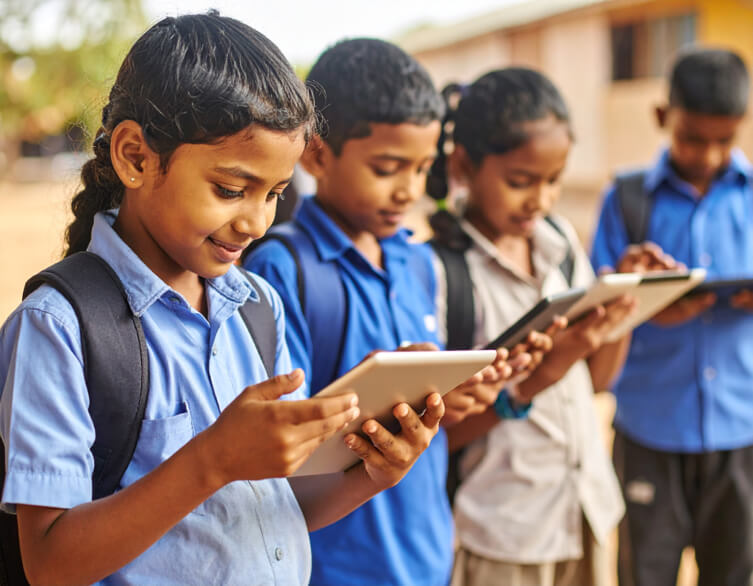Introduction
Stranded on the planet Mars, with limited supplies and no way home, astronaut Mark Watney does not panic. Instead, he problem-solves, codes, calculates and survives by making data-driven decisions. Each small step and improvisation increases his chances of survival on the planet. Mark Watney’s survival in the 2015 sci-fi movie The Martian isn’t driven by luck; it’s driven by data, where each decision is informed, tracked, and refined through digital systems. He uses data to increase his chances of adaptation and survival every day.
Much like Watney, India’s social impact space has seen a remarkable digital transformation in recent decades. Organisations are leveraging technology to amplify their impact and reach millions of beneficiaries at scale, measuring outcomes more accurately and solving innovatively and much faster. The emergence of India’s highly penetrated digital infrastructure of the Aadhaar system, UPI payments, and widespread mobile connectivity, has helped the Indian social sector see unprecedented opportunities to scale their operations and reach the masses.
Transforming Learning through Digital Revolution
Rocket Learning, an ed-tech social sector organisation working in early childhood education, uses Artificial Intelligence (AI) to provide personalised learning experiences for children in underserved communities. Their AI-powered handwriting recognition technology automates the grading of student worksheets, while their machine learning algorithms analyse large-scale assessment data and identify at-risk students early on. They utilise WhatsApp to create digital learning communities, allowing teachers to share automated, age-appropriate content with parents daily, helping reinforce children’s learning with play-based activities using household materials.
Teach for India has embraced digital tools to enhance teacher training and classroom experiences, using data analytics to track the progress of students and effectiveness of teachers. This data-driven approach enables them to demonstrate concrete learning outcomes, attract credibility, and secure continued support from donors and government partners.
Expanding Healthcare Access or Making Healthcare Accessible
Indian organisations working in healthcare are not just adopting global digital health models but are also creating India-specific solutions that address local healthcare challenges. Smile Foundation has integrated telemedicine platforms to enable remote consultations with specialists for rural populations. This hybrid approach combines urban medical expertise to reach the rural community and helps build trust through local health workers.
Sanjivini Society for Mental Health offers online counselling sessions alongside in-person services. Their digital platforms, allowing both online and in-person consultation options, have helped expand mental health awareness to reach the masses across the country.
Scaling Impact in Nutrition and Child Welfare
The Akshaya Patra Foundation has embraced digitisation to optimise its operations in serving millions of mid-day meals to school children. Their digital solutions include automated kitchen systems, real-time tracking of meal distribution, and mobile applications for school administrators for reporting attendance and meal requirements. Their digital dashboard provides real-time visibility into meal preparation and distribution across multiple states, enabling rapid response to any operational challenges.
Child Rights and You (CRY) has successfully developed comprehensive digital platforms, enabling monitoring of child protection cases, coordination with government agencies, and secure databases of children in vulnerable circumstances. This digitisation has significantly improved CRY’s ability to tackle the ugly menace of child labour, ensure school enrollment, and provide suitable and targeted interventions.
Increased Reach and Scaling the Impact
Magic Bus, which leverages sports and outdoor learning to empower children and youth living in poverty, uses an integrated fundraising platform that consolidates donor information, analyses donor patterns and preferences for doing a targeted outreach. Realising that their traditional fundraising methods were often resulting in limited engagement with potential donors, the organisation became one of the early digital adopters as they implemented digital tools and fundraising strategies to measure and report the impact of its programs quantitatively. By showcasing success stories and tangible outcomes through data visualisation, Magic Bus could effectively communicate its value proposition to potential donors.
Self-Employed Women’s Association (SEWA) understands the power of the digital both for themselves as well as for their beneficiaries. SEWA pioneers digital financial literacy programs, training women entrepreneurs to use mobile banking applications and digital payment systems. This has resulted in improved financial inclusion along with the economic empowerment outcomes of SEWA’s programs.
Navigating Digital Challenges in the Indian Context
While the above examples showcase digital potential for the social sector, they might sometimes be difficult to adopt or implement.. Adapting digital solutions for Indian social sector organisations often comes with its unique challenges:
Statistics show that Indian women are less likely to own mobile phones and use mobile internet as compared to men. This means that digital platforms disproportionately serve men, leaving women behind in accessing opportunities such as financial services, education, and social empowerment. Moreover, patriarchal attitudes and cultural norms often restrict women’s use of smartphones, associating frequent phone usage with negative character judgments.
This significantly influences the access, adoption, and utility of digital services and solutions in India. This highly shapes an individual’s technology experiences and the ability of the beneficiaries to engage with digital platforms.
India is home to over 19,500 languages and dialects. Many individuals, especially in rural areas, may not understand the mainstream languages and face the risk of being excluded from digital solutions due to language barriers. This in itself is significantly counterproductive to the goals of social development.
Social sector organisations often handle huge amounts of sensitive beneficiary data, facing unique challenges in digital cybersecurity.
Adapting digital measures might seem daunting to first-time users and hence a strong resistance to adopt new technologies or alter established workflows often arises for both beneficiaries as well as the on-ground staff. This can often slow down the progress instead of hastening it.
So, what do we do?
India’s social sector is a complex fabric of interwoven social issues. Addressing these challenges requires a multi-faceted approach while leveraging the vast digital potential. For instance, organisations need gender-intentional programs working within existing social structures while gradually expanding opportunities for women. Group-based training sessions in traditional community gatherings can make technology adoption feel familiar rather than threatening to established norms. India’s diversity encompasses linguistic differences and complex social hierarchies around gender, caste, and class. This requires going beyond simple language translation to developing user-friendly interfaces that accommodate varying literacy levels through visual aids, voice-based interactions, and intuitive design elements. Organisations must also invest in robust security protocols and comprehensive employee training on data protection best practices, ensuring beneficiary trust while meeting emerging regulatory requirements.
In our conversations at India Leaders for Social Sector, we often hear leaders from some of the most dynamic organisations say, ‘Digital is tough..’ Our reply to them is, ‘Aren’t you already doing one of the toughest jobs in the world and working with some of the most wicked problems?’ It’s time now for organisations to start seeing digital as something that will help and ease their lives.
Conclusion
Digital is no longer peripheral; it’s central to almost everything that we do now. As the Indian social sector grows, supporting leaders and building organisational cultures embracing innovation and change becomes crucial. From data-led program design to real-time service delivery, digital tools are enabling organisations to act faster, reach further, and adapt smarter. Data is replacing guesswork in how voices once unheard are now visible through digital platforms.
It’s true that the social sector requires us to make a lot of ethical decisions with empathy, emotional intelligence and deep awareness of human needs. Hence, it’s imperative for social sector leaders to learn to integrate tech with equity, empathy, and an increased emphasis on preserving ‘human agency’.
Technology and human ingenuity must blend together seamlessly. Hence, by adopting this holistic approach, one that respects cultural contexts while pushing boundaries, prioritises inclusive design over one-size-fits-all solutions, and maintains the highest standards of data security, Indian social organisations can navigate the digital transformation journey successfully while staying true to their mission of serving the most vulnerable populations.
About the Author
Nupur Mahajan has a decade of experience in content creation, training, and facilitation, working across EdTech, Big 4, healthcare, and IT sectors. An entrepreneur at heart, she was a founding team member at Parwarish, leading efforts to unlock human potential. She later worked in both corporate and startup spaces, designing and delivering learning programs for senior women leaders, mid-management, and early talent at Deloitte India Shared Services Pvt. Ltd. As director of learning at Ingenious Faces, she taught a 110-hour design thinking course globally. Nupur holds a master’s in human development and childhood studies (University of Delhi) and is passionate about fostering entrepreneurial mindsets in young talent across India.













